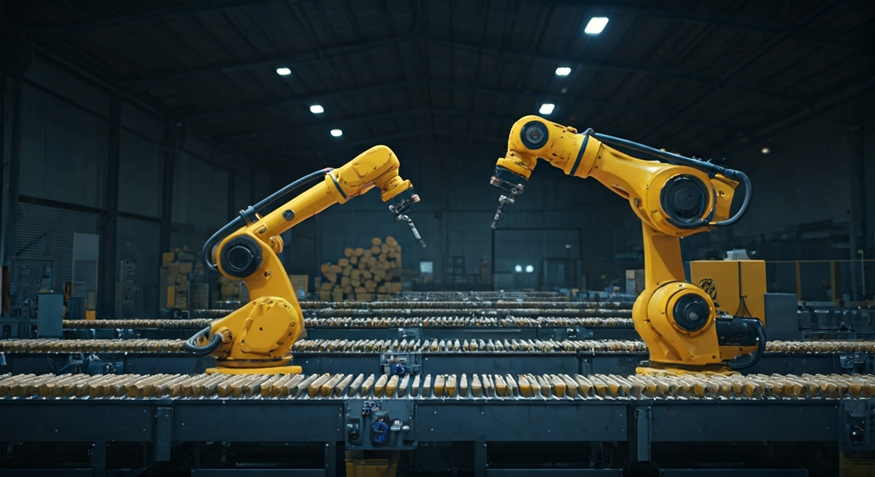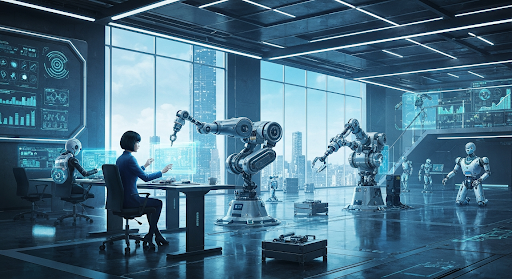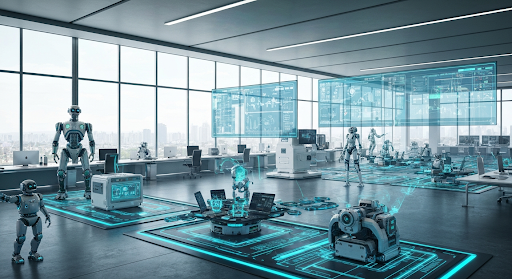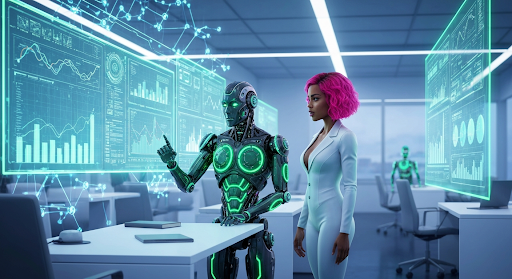Comprehending Robot Automation: Essential Concepts Clarified
Key Highlights
- Robotics is about making physical robots that help with repetitive tasks. These robots have changed the way people do things like material handling and assembly in factories.
- Automation technology uses both hardware and software solutions to make complex tasks easier. These systems work to cut down on how much people have to do, so there is less human intervention.
- Collaborative robots and robotic process automation (RPA) are changing business process automation. They let machines run intelligent operations by using artificial intelligence and machine learning.
- Industrial automation brings different types of systems to the table. These include fixed, programmable, and flexible automation. Each one is set up to fit well with the needs of production environments.
- New trends such as computer vision and process mining are shaping how robotics and automation work together now. In this way, people see a growing connection between both fields.
Keep reading to learn more about each idea and how they improve business process automation.
Introduction
Robots and automation are changing the way industries work. The use of new automation technology and business process automation is making things easier. With robot automation, machines can do repetitive tasks, making work more efficient in both industry and online jobs. The way this works is by joining human intervention with artificial intelligence systems. The goal is to create streamlined processes that help everyone work better. If you want to know how robot and automation solutions can help your company or change how you handle material, this blog will explain key ideas and types in a simple way you can use.
Defining Robotics and Automation

Robotics is about making and setting up machines, often called robots, to do repetitive tasks. You can find these robots at work in many places. They use a mix of engineering, computer science, and artificial intelligence to be good and exact at things like welding, putting things together, and packaging. With robots, there is less manual labor. This change helps people in material handling work faster and get more done.
Automation is more than just using robots. It is a bigger idea that uses automation software and other tools to make things work better. With process automation, the goal is to stop human errors, make things steadier, and have more work done right in many areas. Robotics and automation work well together, so tasks can be handled in a smooth way.
Core Concepts of Robotics
Industrial robots stand at the place where engineering meets computer science. They are programmable machines made for many physical processes. These robots are good at things like material handling, welding, and working on assembly lines. They help set high standards for how careful and correct a task can be. By using these robots, companies can reduce human error and deal with work problems in a better and faster way.
One thing that makes industrial robotics special is their ability to change. The physical robots can be set up to do all kinds of jobs in a workplace. They use their skills to take care of tasks that need to be repeated over and over. This means they can be changed and updated to fit what each industry like automotive or manufacturing needs.
For many industries, using robotics helps move materials and gives them new programmable machines. Now, there are even tools that can work on their own for many tasks. These changes help people do their work with less trouble and keep the work right on target. This is why industrial robots and robotics are now seen as very good and needed helpers wherever there are physical processes and jobs to do.
Core Concepts of Automation
Automation processes use automation software to cut down on human intervention in daily work. With software automation, you can set up programs to handle the same virtual tasks again and again, like sorting data or testing systems. This means people can focus more on bigger, strategic roles. Robotic process automation (RPA) uses machine learning to take care of digital jobs. It gives smart solutions that help get work done well and fast.
Industrial automation is used in physical workspaces. Machines work together to run things like production lines and packaging. These types of process automation show us how automation technology cuts back on human error and helps keep work solid and steady.
When businesses use automation for both digital jobs and hands-on work, they can improve every part of what they do. Intelligent process automation and less manual labor help speed up jobs and make strong, long-lasting business plans. Modern companies rely on automation software and robotic process automation to do more work with less effort, while helping there be a better way to work every day.
Types of Automation in Modern Industries
Automation types are different depending on where and how you use them. Industrial automation deals with real tasks like making products in factories. Process automation, on the other hand, works with things in business jobs that may be online or use virtual tools.
These types are important because they help speed up work and get more done. Fixed systems are used for work that is done over and over, which often includes many physical processes. Flexible setups let a company change how they work to keep up with new or different needs. Because of this, automation keeps changing how we make things and provide services. This lays the ground for us to learn more about fixed, programmable, and flexible automation later.
Fixed, Programmable, and Flexible Automation
Fixed automation systems are used in places where there is a lot of manual labor that repeats over and over. These machines take over jobs like putting parts together. You will often see this on car assembly lines. They keep the work steady and give the same results every time.
Programmable automation systems work in a different way. These machines can be set up to do different tasks. People in many industries can change the automation process when the product changes. This kind of system makes the work more flexible during different production times.
Flexible automation is another step. It brings together the best methods to help companies adjust to the market quickly. Here is a quick look at the differences:
| Type of Automation | Characteristics |
|---|---|
| Fixed Automation | Hard-to-change systems for big batches of the same task |
| Programmable Automation | Programmable machines for different needs |
| Flexible Automation | Systems that can change fast for what the market wants |
All these types of automation help businesses by making their work smoother and faster.
Real-World Use Cases of Automation
Automation helps many sectors like financial services, healthcare, and manufacturing. For example, RPA bots work fast to manage data entry and handle medical records.
- Customer service: Automated systems answer questions. This gives people more time for tougher problems.
- Material handling: Robots sort and put items in packages. This helps make logistics and warehousing better.
- Healthcare: Robotic systems help with surgeries. This makes results better for people.
- Financial operations: Software automation makes jobs like compliance audits easier to do.
Automated solutions help businesses cut costs and work better for people. This allows them to make the most of their resources.
Types of Robots Used in Automation
Today, many industries use different robots. There are collaborative robots, service robots, and industrial machines. Collaborative robots help people work better together. They help in safe tasks and make work faster. This way, production becomes smooth.
Industrial robots and service robots are busy with different jobs. They take care of both simple and complex tasks to fit each work area. Service robots often take care of customer needs or office jobs. Industrial robots mostly do material handling in factories and shops.
Industrial, Service, and Collaborative Robots
Industrial robots are a key part of automation. They carry out fast tasks like putting things together and welding them. In a production environment, these robots help a lot because people need things to be done with great care and accuracy.
Service robots are different because they help people directly. For example, they can clean floors or help with customer service at kiosks. These robots make the customer service process work better and faster.
Collaborative robots, also known as cobots, work with people instead of taking over their jobs. These robots come with safety features, so people feel good working next to them. Many places choose collaborative robots when they want both strong teamwork and employee satisfaction at their workplace.
Key Applications of Robots in the U.S.
Robotics is used in many different U.S. industries now, from image recognition to material handling. Here are a few examples:
- Healthcare: Robots help with giving out medication and taking care of regular hospital tasks.
- Automotive production: Industrial automation helps make jobs like assembly and welding simple and reliable.
- Research exploration: Robots can go to new places, including space or deep parts of the ocean.
- Customer service: Chatbots make customer service better by automating virtual tasks.
The use of robots keeps going up, and this changes U.S. industries. They help make things faster and more efficient.
How Robotics and Automation Work Together
When robotics and automation technology come together, process automation changes in big ways. Physical robots take care of repetitive tasks. At the same time, automation software with artificial intelligence uses human judgment to solve problems.
This mix of physical robots and automation software means smarter workflows. These smart systems handle complex problems and make industrial operations smoother for everyone.
Overlaps and Differences Between Robotics and Automation
Robotics is about physical machines. Automation, on the other hand, also covers virtual things managed by automation software or software solutions. Robots often do jobs, such as welding, that need a real machine. But automation can include running a business process or working with computer science, not just physical processes.
Both robotics and automation have things in common. Their main difference is in what they can do and how they do it. Robots are very good at jobs that move or change real stuff. Software automation builds and controls a virtual space. It helps handle and keep track of data all the time.
When you use robotics and automation together, you get the best of both worlds. Robotics becomes part of a bigger automation process. This combination helps get work done in many industries in a better way.
Integration Challenges and Solutions
Bringing robotics and automation into a workplace can come with a lot of issues:
- Employee satisfaction concerns: Many people at work may feel worried or unsure when robots are added.
- Complex digital solutions: Things like RPA need experts to set them up and get them working right.
- Software-human disconnect: It is hard to use human judgment and still keep the robotics working well with people.
- Data inaccuracies: The output of automated systems can be wrong if the way they are set up is not right.
To fix these problems, companies are working on better training to support digital transformation. They also want smarter RPA implementations and the best ways to bring all these changes together, with a focus on making things work well for people and machines together. This helps improve employee satisfaction and keep the use of human judgment strong as more automation is added.
Conclusion
To sum up, it is important to know the key ideas about robotics and automation in today’s fast-changing world. These tools help to make work easier. They also help to improve how much you can get done in many areas. When people know about the different types of automation and robots, along with what they can do, they are able to make better choices. This lets them decide how to add these tools to their own work process. Using robotics and automation gives you a chance to come up with new ideas and keep up with others in the market. If you want to see how these tools can help your group, reach out to us for a free talk today!
Frequently Asked Questions
What is the difference between robotics and automation?
Robotics is all about making physical robots that do tasks in the physical world. On the other hand, automation uses software to do virtual tasks or to help make bigger business processes run better. The work robotics does often involves doing the same task over and over in real life. But automation technology is wider and can be used for many kinds of virtual tasks, not just in the physical world.
Can automation exist without robots?
Yes, automation does not always need robots. Software automation is there to handle virtual tasks. It can do things like process data or help with scheduling. This works well in business processes, even if there are no physical machines.
Are robots replacing human workers in the U.S.?
Robots help with work by taking care of repetitive tasks. This lets people focus on jobs that need human judgment and deeper thinking. In production places, robots work alongside people. They help, but do not take over all the jobs.
What are the main benefits of automated robots?
Automated robots help get work done faster. They also cut down on human error and make things work better at work. This can make employees happier in places where things are made. Their steady work helps balance manual labor with precise automation.
What trends are shaping the future of robots automation?
New trends in robotics show how artificial intelligence, machine learning, and process mining are getting used more in robot systems. Collaborative robots, also called cobots, are becoming common. At the same time, new tools like computer vision keep making progress. Now, robots are mixing process automation with more smart features, like intelligent process automation. This lets robots be more flexible and able to do many different jobs.



